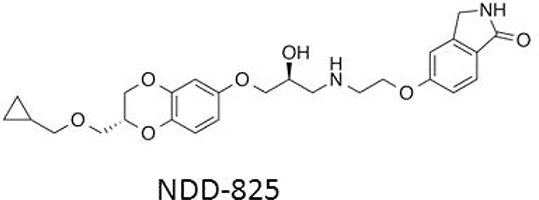Print version
Search Pub Med
| 127P London, UK Pharmacology 2016 |
Development of novel selective beta 1-adrenoceptor antagonists for concomitant cardiovascular and respiratory disease
Introduction. β-blockers reduce mortality in people with heart disease. Clinical β-blockers have poor cardioselectivity (β1-adrenoceptor (AR) affinity) over the lung β2-AR. Unwanted β2-blockade risks causing life-threatening bronchospasm and reducing the effectiveness of β2-agonist emergency rescue therapy. Consequently, people with heart disease and asthma are unable to take current life-prolonging β-blockers. In order to overcome this limitation, we have synthesized highly β1-selective compounds.
Method. From over 1000 novel β-blockers, NDD-825 was chosen for detailed evaluation. Studies involved 3H-CGP12177 whole cell binding, 3H-cAMP accumulation, ERK1/2 MAP Kinase activity assays (CHO-β1 and CHO-β2 cells 1) and monitoring heart rate (HR) and hind quarters conductance (HQC) in conscious Sprague-Dawley rats 2.
Results. 3H-CGP12177 binding yielded a log KD of -8.28±0.05 (n=20) for the human β1-AR, and -5.27±0.03 (n=16) for the human β2-AR (β1-selectivity of 1023-fold). NDD-825 did not stimulate any 3H-cAMP accumulation response (β1 or β2-AR, n=8), although NDD-825 caused rightward parallel shifts of cimaterol dose response curves (yielding log KD values of β1 -8.99±0.05 (n=9; Schild plot 1.04±0.02, n=3) and β2 -5.75±0.06 (n=4); β1-selectivity 1738-fold). No NDD-825 responses were observed for CRE-gene transcription (n=5), or direct measures of ERK1/2 phosphorylation (n=4). In a panel of 80 GPCRs and ion channels, only binding to the 5-HT2A receptor was detected (5.8μM, β1-selectivity of 1115-fold). In rats, NDD-825 (iv bolus 2mg/kg, infusion 1mg/kg/h) suppressed β1-mediated HR (basal and isoprenaline-induced HR) but had no effect on β2-mediated HQC responses (n=4 rats), with HR still suppressed 24h post NDD-825 infusion. Given orally, 3 and 10mg/kg NDD-825 reduced basal and isoprenaline-induced HR with no effect on HQC (n=3 rats). NDD-825 had a long pharmacokinetic clearance with a single oral dose of 20mg/kg never reaching plasma concentrations sufficient to block the β2-AR, despite remaining above that required for β1-blockade for 24hr. NDD-825 (10µM) had no cytotoxic effects (HepG2 cell viability assays), no hERG channel affinity and no genotoxicity effects (AMES test). ADME properties were good and NDD-825 was well tolerated at the highest dose tested (300mg/kg daily) in a 7-day repeat-dose oral rat toxicology study, without any macro- or microscopic changes at autopsy.
Conclusion. NDD-825 is an orally bioavailable highly β1-selective β-blocker, with no intrinsic efficacy, no apparent off-target interactions, good disposition properties and no adverse toxicological effects. NDD-825 offers a truly cardioselective β-blocker that may benefit people with both heart and respiratory disease.
References.
1. Baker JG et al., (2011) FASEB J 25:4486-4497.
2. Baker JG et al., (2013) PLoS ONE 8(11): e77582. doi:10.1371/journal.pone.0077582


